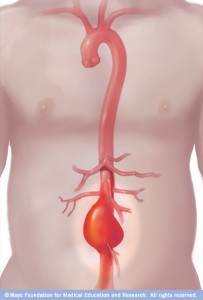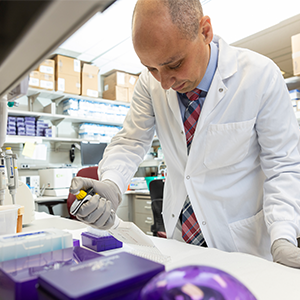-
Abdominal Aortic Aneurysms: Mayo Surgeon Explains Who Needs Screening, Treatment
Bulges in body’s major blood vessel can cause potentially lethal ruptures, blood clots
 An abdominal aortic aneurysm is a potentially life-threatening condition: If the body’s major blood vessel ruptures, it can prove deadly. The U.S. Preventive Services Task Force recently updated its recommendations on screening. Mayo Clinic vascular surgeon Peter Gloviczki, M.D., explains who should be watched for abdominal aortic aneurysms, how they are diagnosed and how surgery, which now includes a less invasive endovascular option, is improving survival rates:
An abdominal aortic aneurysm is a potentially life-threatening condition: If the body’s major blood vessel ruptures, it can prove deadly. The U.S. Preventive Services Task Force recently updated its recommendations on screening. Mayo Clinic vascular surgeon Peter Gloviczki, M.D., explains who should be watched for abdominal aortic aneurysms, how they are diagnosed and how surgery, which now includes a less invasive endovascular option, is improving survival rates:
What abdominal aortic aneurysms are: a bulge in the aorta, which is the body’s largest artery and is located in the abdomen above the belly button. The greatest risk is that the aneurysm will rupture.
“With every heartbeat there is increased pressure on the area of the aorta that has a weak wall and it bulges out, and ultimately when it reaches a certain size, it is going to rupture,” says Dr. Gloviczki, the Joe M. and Ruth Roberts Professor of Surgery at Mayo Clinic and past president of the Society for Vascular Surgery. “And rupture is a lethal complication.”
Who should be screened even if they have no symptoms: Men are at higher risk than women. The U.S. Preventive Services Task Force recommends that men 65 to 75 who smoke or were smokers get screened once with an ultrasound.
Mayo Clinic follows the recommendations of the “Welcome to Medicare” program, which covers screening for men who are smokers or have smoked and men and women who have a family history of abdominal aortic aneurysms, Dr. Gloviczki says. Male smokers with no symptoms of abdominal aortic aneurysms should be screened at age 65, and, as the Society for Vascular Surgery recommends, screening should start at 55 for people with a family history of the condition, he says.
Patients with chronic obstructive pulmonary disease, coronary artery disease, atherosclerosis or high cholesterol should consult with their physicians on whether they should be screened, Dr. Gloviczki says.
How abdominal aortic aneurysms are diagnosed: a physical examination and imaging such as an ultrasound, CT scan or MRI.
Symptoms of an abdominal aortic aneurysm: The condition is especially dangerous because many people do not know they have it, and time is of the essence when an aneurysm ruptures, Dr. Gloviczki says, adding that a common lack of symptoms makes screening high-risk people even more important.
“The problem is patients don’t know they have an abdominal aortic aneurysm and they don’t act expeditiously. If you know you have one, you will get to an emergency room,” Dr. Gloviczki says.
“The key here is to get to an emergency room. React immediately to any new-onset abdominal or back pain or a fainting spell and dial 911 or get taken to an emergency room very rapidly, because there are always a few hours where we can act and our chances are better to save you,” he adds.
How they are treated: What is done depends on the risk of rupture, Dr. Gloviczki says.
Typically, surgery to repair the aneurysm will be recommended if the aneurysm reaches 5.5 centimeters in size, or is growing rapidly, or there are symptoms, he says. Abdominal aortic aneurysms rarely can cause leg pain and build up blood clots that break loose and block arteries in the legs. If none of the above apply, your vascular surgeon may choose instead to keep an eye on it.
Much progress has been made in the past 20 years in abdominal aortic aneurysm repair, Dr. Gloviczki says. Less invasive endovascular repair, in which stents are inserted and no incision is made in the abdomen, is now done in more than 70 percent of patients, he says. As a result, in the past decade, U.S. deaths related to abdominal aortic aneurysm repair surgery have fallen from 4.4 percent to 2.8 percent, a 36 percent decline.
“This is a larger decrease in mortality than any of the major surgical interventions that are performed today, including heart surgery, transplantation or orthopedic procedures,” Dr. Gloviczki says. “The odds are better and better, and the endovascular technique clearly decreases the early mortality.”
In some complex cases, aneurysm bulges can extend to blood vessels branching off the aorta, requiring use of multi-branched stents for endovascular repair. Mayo Clinic vascular surgeon Gustavo Oderich, M.D., is leading several clinical trials to test branched stents.
Journalists: Soundbites of Dr. Gloviczki are available in the downloads below. For interviews with Dr. Gloviczki or Dr. Oderich, please contact Sharon Theimer in Mayo Clinic Public Affairs at newsbureau@mayo.edu or 507-284-5005.







